J ZENTMAYER ANTIQUE BRASS GRAND AMERICAN MICROSCOPE WithCASE & ACCESSORIES C1865

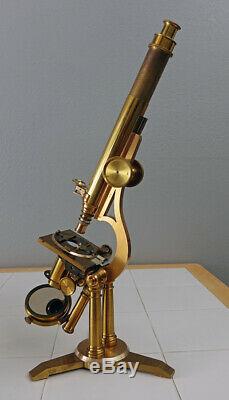
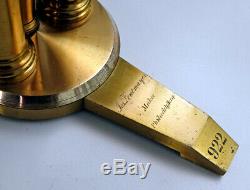

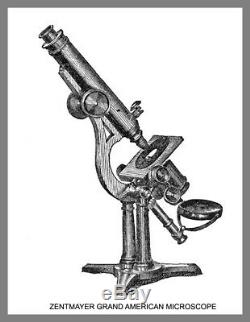
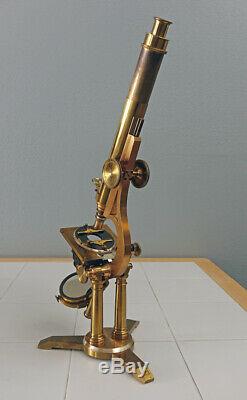

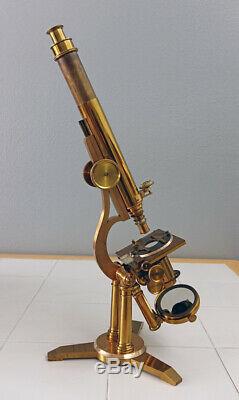
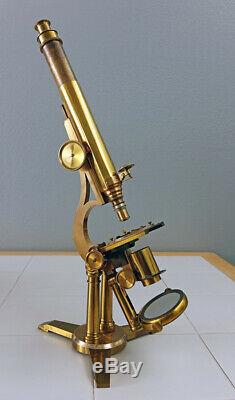

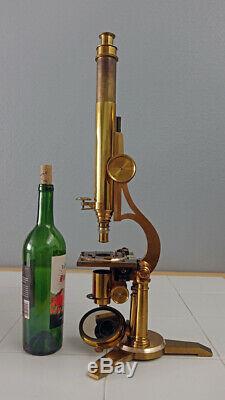
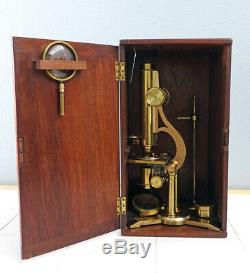

J ZENTMAYER ANTIQUE BRASS GRAND AMERICAN MICROSCOPE W/CASE & ACCESSORIES C1865. JOSEPH ZENTMAYER ANTIQUE BRASS GRAND AMERICAN MICROSCOPE SN-922 WITH WALNUT WOOD CASE & ACCESSORIES Circa 1865. Featured here is Zentmayers double pillar Grand American Microscope.
Built from 1858 to 1876, when it was replaced by the American Centennial stand, this model was considered to be Americas finest microscope. And, it still remains one of the most beautiful and desirable antique brass microscopes that one can have in any microscope collection. Its a true classic instrument in every sense of the word. It is immediately identified by astute collectors as the Grand American stand by the unique triangular notch in the limb (see close-up image).
Included with the microscope itself is a very large Bullseye condenser on a tall brass stand, a very unique Lieberkuhn in a brass storage canister, and a very nice dovetailed Walnut wood cabinet that houses the instrument along with the included accessories. Joseph Zentmayer is identified as the maker of this instrument as it is signed, Jos. Zentmayer, Maker, Philadelphia, in fancy script on the top of one of the tripod feet (see close-up image).
In addition, this microscope bears the serial number, 922, which dates the instrument to circa 1865. NOTE: For a brief history of the Zentmayer optical firm, please see below. Accompanying this listing, for comparison with the instrument featured here, is a catalogue cut of this very microscope model extracted from my personal copy of the Catalogue of Optical & Philosophical Instruments, For Sale Wholesale And Retail, By William Y. McAllister, 728 Chestnut Street, Philadelphia 1867.
William McAllister was for a time a Philadelphia sales agent for Zentmayer microscopes, which were prominently featured in his catalogues. This antique brass microscope will make an outstanding addition to any antique microscope collection, especially one that has an emphasis on classic American made instruments. This Grand American Microscope is built upon a heavy brass flat tripod foot. Atop the foot is a rotating brass disc the edge of which is tapered, silvered and inscribed with a numbered scale (see close-up image). This arrangement was designed by Zentmayer to assist in measuring the angular aperture of objective lenses. Although not originally intended by its maker, it later proved to be useful to specialty users to facilitate microphotography. The numbered scale is found on half of the discs circumference, although the disc along with the microscope itself can be rotated a full 360 degrees on its tripod base.Rising from this brass disc atop the foot is a pair of nicely sculpted tapered cylindrical brass pillars that are attached at the top to a trunnion joint. This joint permits all degrees of inclination of the microscope from the perpendicular to the horizontal. Also affixed at the joint is a very nicely sculpted angular Jackson-Lister type limb that extends both above and below the trunnion joint. The limb is one solid piece of brass which incorporates the support for the main optical tube, the coarse focus mechanism, the stage, the substage apparatus, and a protruding part into which fits a swinging tailpiece that supports the plano-concave mirror.
The limb has a curved triangular cutout distinctive to all of Zentmayer's Grand American Microscopes. Mechanically attached to the lower end of the leading edge of the limb is a 102 by 110 mm rectangular brass stage. Some fancy scroll work is found atop the brass stage plate. The mechanical stage is operated on both the x and y axes via worm gears that are independently operated with respective brass milled heads found on the right side of the instrument. At the rear of the stage are engraved scales that mark the movement on both the x and y axes.
Atop the rectangular stage is a manually operated adjustable rotating slide holder that has a silvered graduated scale on its chamfered edge. The graduated scale allows the slide holder to act as a goniometer to determine the angles of crystals that are observed with the microscope. The slide carrier can be manually rotated a full 360 degrees. The central aperture of this unit is 30 mm in diameter. Note: The early versions of the rectangular stage used on the Grand American stand employed a worm gear on the x axis and a fusee chain drive mechanism on the y axis.Both axes were operated by a single control rod with concentric milled heads on the right side of the stage and a single milled head on the left side of the stage. As an option, Zentmayer also offered a circular mechanical stage with a different style gliding slide holder that moved over a glass plate affixed to the rear of the stage surface. Thus, one will normally find either one of these stage types on most of the surviving Grand American instruments. However, the instrument featured here has a stage that features a modification of Zentmayers original rectangular stage with the fusee chain drive on the y axis replaced by a worm gear.
Based on a close examination of the stage mechanics and the parts employed, this appears to be an original modification of the stage of this microscope by Zentmayer himself and not a third party aftermarket modification. Zentmayer was well known for making changes to his instruments as he went along and experimented with various alternative designs over time. Army Hospital Microscope, which underwent multiple improvements over its history, is a case in point. All indications are that this appears to be the case with the stage found on this particular instrument. The substage of this instrument features an oversized 80mm diameter brass mounted plano-concave mirror on a swinging tailpiece.
The yoke mounted mirror can be moved closer to or away from the stage within a groove in the front of the tailpiece using a pair of brass handles found on the mirror mounting. Also found in the substage is a cylindrical brass accessory holder or sleeve that is operated by rack and pinion. This unit is designed to accommodate various accessories including alternative condensers or substage polarizers, etc. In this case, it comes equipped with a brass wheel of apertures that fits into the distal end of the cylinder. Affixed to the body tube of the microscope is a tapered male bar track with a rack that fits into a female receptor channel on the leading edge of the limb.
The rackwork on this microscope is horizontal in nature and not angled. A pinion gear assembly with a pair of oversized brass milled heads for control is housed in a brass gearbox that is inset into the rear of the limb. It engages the rackwork and allows for coarse focus. Fine focus is by a nose mounted lever on the distal end of the body tube that is operated by a screw with a graduated silvered brass knob (see close-up image). The lever moves an internal spring loaded sleeve that is attached to the objective lens allowing for a positive form of fine focus. The lacquered brass body tube of this microscope features a drawtube that is calibrated in 1/8th inch increments, over a four inch range, and labeled every inch. The drawtube is threaded at its distal end to accept an analyzer or an erecting lens. This microscope comes with a single large diameter top-hat-style eyepiece that is found at the top of the drawtube. At the lower end of the body tube is a single dual part RMS objective made by W. Note: Zentmayer often offered Wales objectives with his instruments. This objective lens has an adjustable correction collar and removable lower lens element allowing for dual magnifications.When the body tube is racked down to its lowest level and the drawtube is fully nested within the body tube for storage within the wood case, this microscope stands about 17 inches tall (as measured from the base of the foot to the top of the drawtube). When the instrument is set up for observations with the eyepiece and objective in place and the drawtube fully extended to the 4-inch mark, the microscope stands about 24 inches tall, making for a very tall and impressive instrument indeed.
Note: Please see the accompanying image that shows the height of the microscope compared to a standard bottle of wine. The microscope weighs about 13 pounds. This microscope comes in a very nicely appointed dovetailed Walnut case with a brass carrying handle.However, typical of many microscope cases from the past, this case is missing its lock mechanism and key. The interior base of the case has a wood cutout with restraint peg for the weighted brass base of the Bullseye stand and a rack on the door that holds the Bullseye lens.
The exterior dimensions of the wood case are 19.25 inches tall, 10.25 inches wide and 9 inches deep. The microscope plus the listed accessories in the case weighs about 23 pounds. Accessories included with this microscope include a very large 75mm diameter Bullseye condenser with adjustable stand along with a brass canister that holds a very unique Lieberkuhn that has an adjustable lower reflective element a type that I have not seen before (see close-up image). There is no makers mark associated with this accessory, but it is assumed that it is made by Zentmayer. This Lieberkuhn is used in conjunction with the Bullseye to illuminate opaque specimens for examination under the microscope.
An image that accompanies this listing shows it in use on the stage. NOTE: The accompanying images, which were captured under ambient light conditions, are a part of this condition statement. Please take the time to view all of the images so you can confirm the condition of the microscope and so you will know exactly what you will be getting should you be the very fortunate new owner of this fine antique brass Zentmayer microscope. In summary, this microscope is in very good to excellent cosmetic, optical, and mechanical condition with just a few minor caveats as noted below. Overall, the brass work on this instrument is in very good to excellent condition as the accompanying images will attest.I would estimate original lacquer retention on this instrument to be close to 100% with only a few small spots of surficial tarnish present on the body tube, foot, pillars or limb. The only cosmetic treatment we have given this microscope is to clean it with dilute Windex and then to give the brass work a coat of Renaissance Micro-Crystalline Wax from the GEMMARY to preserve it. NOTE: We make it our firm policy not to deep clean and polish antique brass microscopes.
We did go ahead and clean the silvered edges of the base brass disc, the edges of the slide holder and the edges of the fine focus knob to reveal the engraved numbers as these were obscured by tarnish. We also replaced the corks under the three tripod feet as these were missing.
The optics that come with this microscope are in very good to excellent condition. The eyepiece and objective lens are free of any fungus, fogging, delamination or other optical defects. The exterior cosmetic condition of the objective lens is considered to be good.
The plano-concave mirror is in relatively good condition with no evidence of any loss of silvering on the plano side. However, the concave side displays a white haze on the surface, but it still provides adequate illumination to the stage. Both the coarse and fine focus mechanisms on this microscope function smoothly. The horizontal rack on the body tube is perfect with no defects.
Both the x and y movements of the stage are smooth and precise. The slide holder atop the stage rotates freely without binding. The microscope rotates freely about its base. The swinging tailpiece for the mirror works smoothly. The Walnut case that accompanies this instrument is in very good to excellent fully functional condition. It is the original case for the instrument. However, as is noted above, it is missing both its lock mechanism and key. However, the case door tends to stay closed when the instrument is stored inside. There are a couple of age cracks on the rear of the case, but these do not affect the overall structural integrity of the case. The Bullseye itself and its stand are in excellent condition.The Liberkuhn is also in excellent condition with no loss of silvering on its reflective elements. In summary, this is a very handsome instrument not only from the standpoint of its overall physical beauty and its unique design features, but also from its superb performance, both optically and mechanically. It is still to this day a fully functional microscope. It is certain to be a highly prized addition to any antique microscope collection.
Zentmayer was born in Manheim, Germany on March 27, 1826. He learned his trade as a maker of mathematical, optical and astronomical instruments in his hometown, and subsequently in Karlsruhe, Frankfort, Munich, and later in Hamburg. In Hamburg he was associated with the optical firm of Repsold Brothers, who specialized in the manufacture of astronomical instruments, which were found in many of the finest observatories in Europe. For a time, he worked in Washington, Cleveland, and later in Philadelphia with the optical firm of Young & Sons, who made surveying instruments.
In 1853, he went into business for himself. Working in a small room with just a single small foot operated lathe, he began to build custom microscopes. About the year 1858 he produced his first marketable microscope, which became known as the Grand American. His microscopes based on the Grand American stand and pattern were highly praised in the Proceedings of the American Philosophical Society in 1859.
Zentmayer produced his Grand American microscope from 1858 to 1876. In 1862, Zentmayer began building his first iteration of the U. Army Hospital Microscope to meet the needs of the Union Army in the Civil War. This microscope became his most popular model in terms of numbers produced and was manufactured with progressive improvements and modifications for over 30 years.
In 1870, the American Journal of Science reported on a new mechanical manipulator that was invented by Zentmayer. Dubbed The Mechanical Finger, it could be mounted on almost any microscope stage. It allowed the operator to manipulate diatoms and other small objects on a glass slide with relative ease.
In fact, it was the first micromanipulator that was not clunky and really worked. Zentmayers basic design concept for a micromanipulator is still in use today on many microscopes used in the medical field and in biological research. In 1876, Zentmayer was issued a patent U. Patent # 181,120 for a swinging sub-stage assembly and mirror, as well as a redesigned fine focus mechanism that consisted of a long lever mounted in the limb of the microscope.
The swinging sub-stage assembly was a real innovation. It allowed the operator to rotate the illuminating apparatus completely around the object without disturbing the focus. Zentmayer included these innovations in his microscopes manufactured after the issuance of the Patent.
It appeared in the American Histological, the latter versions of the US Army Hospital Microscope and in the American Student Microscopes offered by the firm. It also appeared in a new microscope called the American Centennial in recognition of the centennial of the American Revolution.
This new instrument debuted at the 1876 Philadelphia International Exhibition and received great praise and, ultimately, wide acceptance. Later, in 1893, the American Histological Microscope stand was improved with the substitution of a larger and broader Y shaped tripod base, a larger stage and a sliding mirror extension. It too included the swinging substage assembly. This microscope came to be known as the American Columbian in honor of the Worlds Columbian Exposition in Chicago, IL. However, circumstances prevented its exhibition there. Nevertheless, this improved Histological Microscope retained its new name for marketing purposes.Zentmayer is responsible for several other innovations in the design of the microscope including, but not limited to, an erecting prism for the binocular microscope and a new portable folding microscope. He also designed a fine double meniscus lens for the newly rising profession of photography.
Joseph Zentmayer died in 1888 after a prolonged illness. His sons continued the optical business that he established until at least the year 1895.After this time, the business seems to have faded into the mists of history and most likely did not continue operations into the 20th Century. We will also entertain reasonable offers for this exceptional instrument. FREE scheduling, supersized images and templates.
Make your listings stand out with FREE Vendio custom templates! Over 100,000,000 served. Get FREE counters from Vendio today!
The item "J ZENTMAYER ANTIQUE BRASS GRAND AMERICAN MICROSCOPE WithCASE & ACCESSORIES C1865" is in sale since Thursday, February 28, 2019. This item is in the category "Collectibles\Science & Medicine (1930-Now)\Scientific Instruments\Microscopes, Lab Equipment". The seller is "mtloggera" and is located in Hamilton, Montana. This item can be shipped worldwide.
- Antique Brass Microscope: Grand American Microscope
- Country of Manufacture: United States of America
- Manufacturer: Joseph Zentmayer
- Product Type: Microscopes, Lab Equipment

